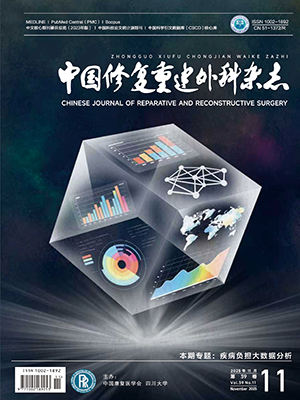【Abstract】 Objective To establ ish an artificial physiological reflex arc with reconstruction of the sensory and the
motorial functions of atonic bladder simultaneously after the conus medullary injury in rats. Methods Twenty 3-month-old
male SD rats, with the weight of 250 to 300 g, were included. The right side was the experimental side, while the left side served as a control. Intradural microanastomosis of the right L5 ventral root to S2 ventral root and L5 dorsal root to S2 dorsal root wasperformed to reconstruct the sensory and the motorial functions of atonic bladder. After axonal regeneration, the new motor-tomotor and sensory-to-sensory artificial bladder reflex pathway was establ ished. At 5 months postoperatively, the early function of the reflex arc was observed by electrophysiological examinations, and the bladder pressure was tested. Results Eighteen rats survived for 5 months after the operation. Single stimul i (3 mA, 0.3 ms) of the S2 dorsal root of the experimental side resulted in evoked potentials recorded from the right vesical plexus before and after the spinal cord was destroyed horizontally between L6 and S4 segmental levels. The ampl itudes of the evoked potentials were (0.10 ± 0.02) mV and (0.11 ± 0.03) mV, respectively, before and after paraplegia, and there was no statistically significant difference (P gt; 0.05). The figures of the evoked potentials were similar to those of the control side. Bladder contraction was initiated by trains of stimul i (3 mA, 20 Hz, 5 s) of the S2 dorsal root of the experimental side. The bladder pressures were (6.55 ± 1.33) cmH2O and (6.11 ± 2.01) cmH2O, respectively, and the ampl itudes of bladder smooth muscle complex action potential were (0.11 ± 0.02) mV and (0.11 ± 0.03) mV, respectively, before
and after paraplegia. There was no significant difference (P gt; 0.05). These figures were similar to those of the control side before paraplegia. Before paraplegia, when the S2 dorsal root of the control side was stimulated, the ampl itude of the evoked potential was (0.14 ± 0.02) mV, the bladder pressures was (10.77 ± 1.78) cmH2O and the ampl itude of bladder smooth muscle complex action potential was (0.17 ± 0.02) mV. There was statistically significant difference bewteen the experimental side and the control side (P lt; 0.01). All the results of electrophysiological examinations and bladder pressure were negative when the left S2 dorsal root was stimulated after paraplegia. Conclusion Suprasacral nerve motor-to-motor and sensory-to-sensory transfers after the spinal cord injury to reconstruct the bladder autonomic reflex arc by intradural microanastomosis of ventral root and the dorsal root between L5 and S2 simultaneously is practical in a rat model and may have potential in cl inical appl ication.
Citation: LIN Haodong,HOU Chunlin,ZHENG Xianyou,XU Zhen,WANG Jianhuo.. AN EXPERIMENTAL STUDY OF ESTABLISHMENT OF PHYSIOLOGICAL REFLEX ARC AFTER CONUSMEDULLARY INJURY IN RATS. Chinese Journal of Reparative and Reconstructive Surgery, 2008, 22(6): 719-723. doi: Copy
Copyright © the editorial department of Chinese Journal of Reparative and Reconstructive Surgery of West China Medical Publisher. All rights reserved




